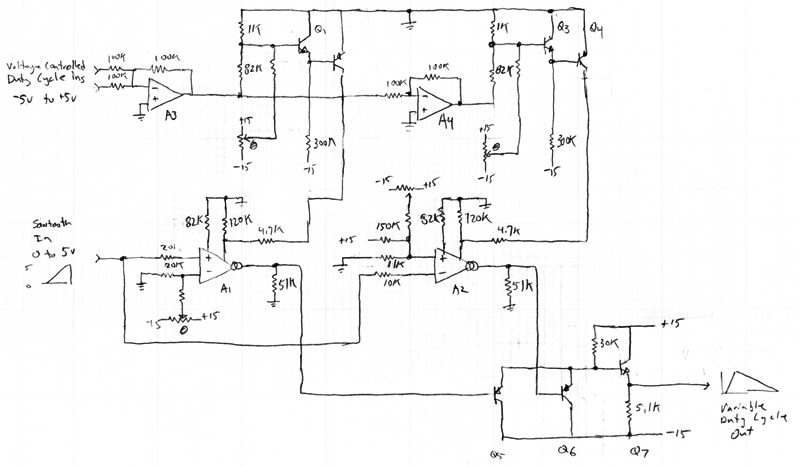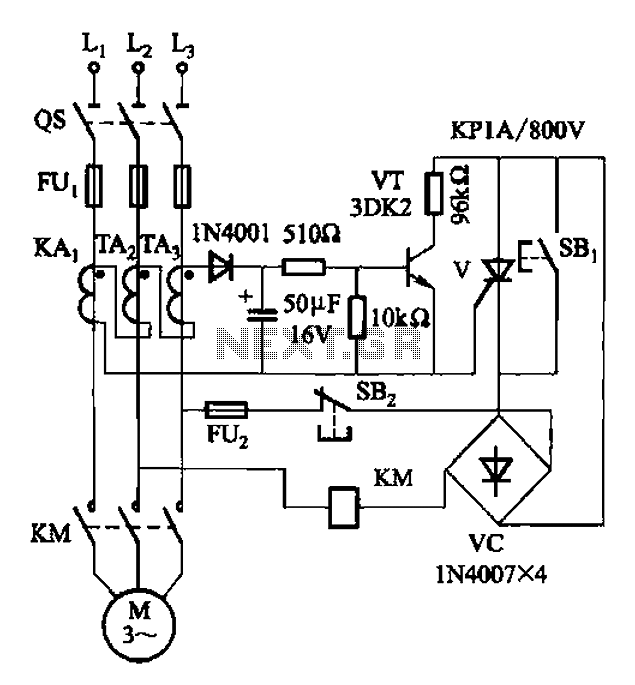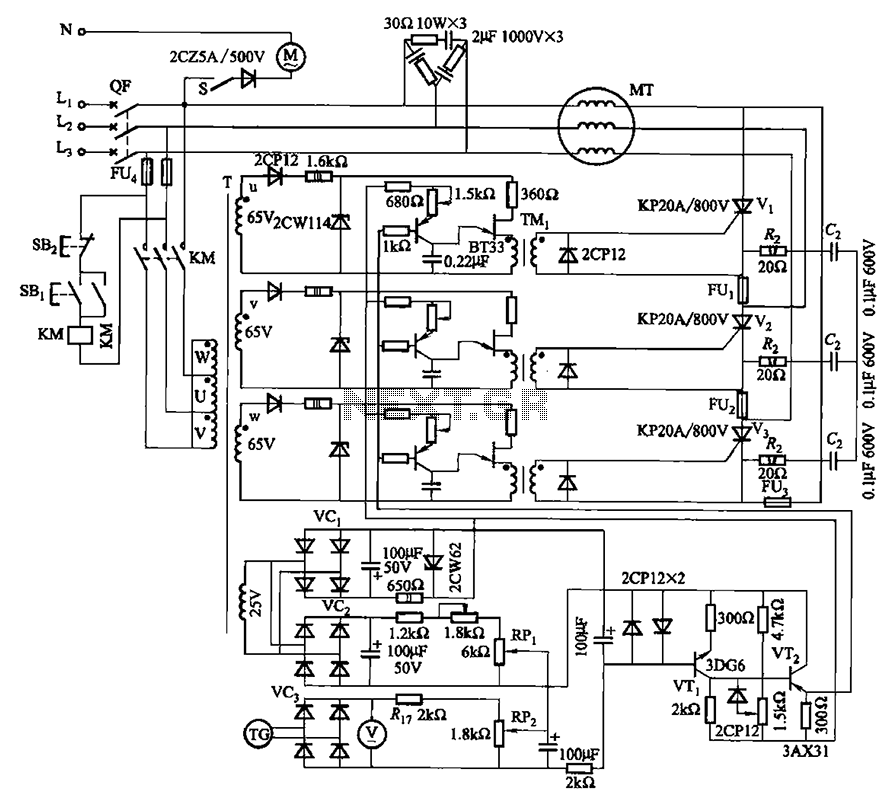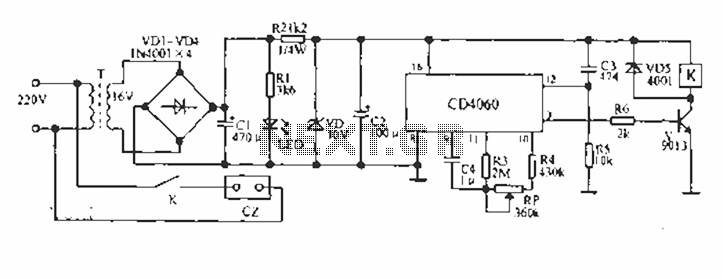
Voltage Controlled Duty Cycle Sawtooth Circuit

A discussion took place on synth-diy regarding the challenges of constructing a voltage-controlled oscillator with a sawtooth wave output, where the duty cycle (the ratio of ramp-up time to ramp-down time) can be adjusted using a separate control voltage. The schematic presented features an audio frequency rising sawtooth wave input ranging from 0.0V to +5.0V on the left side, while the upper left input is a duty cycle control voltage varying from -5.0V (falling sawtooth) through 0.0V (triangle wave) to +5.0V (rising sawtooth). The power supply operates at ±15.0V. Operational transconductance amplifiers (OTAs) A1 and A2 are CA3280 models, and A3 and A4 are LF412 op-amps. The circuit employs high beta NPN and PNP transistors. The trimming circuitry values are intentionally omitted. The fundamental concept is to utilize the rising sawtooth source and its inverse, the falling sawtooth, adjust their relative gains, and derive the arithmetic minimum of the two signals as the output. The gains ideally range from 1.0 to infinity, but are practically limited to between 1.11 and 10. When both gains equal 2.0, the output manifests as a triangle wave. To maintain constant output amplitude, the sum of the reciprocals of the gains must remain constant, with a unity value required for the output amplitude to match the input amplitude. The variable x is proportional to the duty cycle control voltage, centered around zero for a 50% duty cycle. The expression 1+ex corresponds to one of the gains, while 1+e-x corresponds to the other. The terms ex and e-x are implemented using basic ARP-style exponential circuits, with the constants in the denominators derived from resistor currents. The signal path begins with the provided sawtooth wave. A1 and A2 are configured to operate at 0.24 mA for a 50% duty cycle, ensuring sufficient headroom for gain adjustments while allowing the lowest gain to drive the output to full amplitude. The 82k resistors set the OTAs' input diode current to 170 µA, yielding a diode resistance of 416 ohms, resulting in an input attenuation of 1/100th, which accommodates the input amplitude effectively. The OTA bias current of 0.24 mA (for the triangle wave) and the 51k ohm output resistor establish a total gain of 2.0. Transistors Q5 and Q6 function as emitter followers, with the lowest voltage taking precedence. The output emitter follower compensates for the offset voltage from the preceding transistors. Op-amp A3 mixes the input control voltages, while A4 provides the negative feedback. Both signals are routed to the ARP-style exponential circuits, which are adjusted to idle at 0.12 mA each. The 120k ohm resistors contribute to the constants in the denominators of the equation, while the 4.7k ohm resistors limit the control current into the OTAs to a manageable level. A correction is noted regarding the resistor values at the inputs of A2, which should be, from top to bottom, 62k, 39k, and 20k, to properly bias A2's input so that the sawtooth effectively ramps down from 5.0 volts.
This circuit schematic outlines a voltage-controlled oscillator designed for synthesizer applications, specifically targeting the generation of adjustable duty cycle sawtooth waveforms. The use of CA3280 OTAs allows for precise control over the output characteristics, leveraging their transconductance properties to achieve the desired gain adjustments. The incorporation of LF412 op-amps ensures low noise and high-speed operation, which is critical in audio frequency applications.
The design emphasizes the importance of maintaining a consistent output amplitude while varying the duty cycle, which can significantly impact the harmonic content of the generated waveform. By utilizing exponential circuits to manage the gains, the circuit can achieve a smooth transition between different duty cycles, enhancing the musicality of the output.
Moreover, the emitter follower configuration employed by transistors Q5 and Q6 serves to buffer the output, thus preserving signal integrity while allowing for the necessary voltage level adjustments. The careful selection of resistor values throughout the circuit ensures optimal performance, addressing both input and feedback paths to maintain stability and linearity in the oscillator's response.
Overall, this schematic serves as a robust foundation for synthesizer enthusiasts and engineers looking to explore the creative possibilities of voltage-controlled oscillators with adjustable duty cycles, facilitating innovative sound design and musical expression.There was a discussion on synth-diy a while ago about the problems of building a voltage controlled oscillator with a sawtooth wave output whose duty cycle (the ratio of ramp-up time to ramp-down time) is adjustable with a seperate control voltage. [Don: When you get around to it, talk about the musical advantages of such a thing, morphing, the ha rmonic spectra, the way to build a potentiometer controlled variable duty cycle oscillator, why you can`t just integrate a PWM square wave, and so forth. ] In the following schematic, the input on the left is an audio frequency rising sawtooth wave going from 0.
0V to +5. 0V. The input on the upper left is a duty cycle control voltage going from -5. 0V (falling sawtooth) through 0. 0V (triangle wave) to +5. 0V (rising sawtooth). The power supply is +/- 15. 0V. A1 and A2 are CA3280 OTAs. A3 and A4 are LF412 op amps. The transistors are reasonable high beta NPNs and PNPs. The values for the trimming circuitry is intentionally left off. The basic idea is to take our rising sawtooth source and it`s inverse, a falling sawtooth from +5. 0V to 0. 0V, adjust the relative gains of those two, and use the arithmetic minimum of those two signals as the output. The gains would ideally go from 1. 0 to infinity, but for practical reasons I`ve limited the range to 1. 11 through 10. If the two gains are equal to 2. 0 the output will be a triangle wave. To keep the output amplitude constant the two gains should be such that the sum of the recipricals of the gains is constant.
And if the output amplitude is going to be the same as the input amplitude, that constant value needs to be unity. For this application, x is proportional to the duty cycle control voltage, centered around zero for a 50% duty cycle.
1+ex is proportional to one of the gains and 1+e-x is proportional to the other. The ex and e-x are implemented with simple ARP-style exponential circuits, and the 1s in the denominators are currents from resistors. The signal path starts with the given sawtooth wave. A1 and A2 are set up run at 0. 24 mA for a 50% duty cycle; we need plenty of headroom to increase this gain, but the current for the lowest gain still needs to drive the output to full amplitude.
The 82k resistors set the OTAs` input diode current to 170uA, for a diode resistance of 416 ohms, for an input attenuation of 1/100th, easily accomodating the input amplitude. From here, an OTA bias current of 0. 24mA (triangle wave) and the 51k ohm output resistor will set the total gain to 2. 0. Transistors Q5 and Q6 are emitter followers with the lowest voltage taking over. The output emitter follower compensates for the offset voltage of the previous transistor two. Not exactly, but close enough for now. Op amp A3 creates mixes the input control voltages, op amp A4 provides the negative. Both of these go to the ARP-style exponential circuits. Adjust them to idle at 0. 12mA each. The 120kohm resistors are responsible for the 1s in the denominators of the equation and the 4. 7kohm resistors limit the control current into the OTAs to a reasonble value. Correction: The resistor values on the inputs of A2 are wrong. They should be, top to bottom, 62k, 39k, and 20k. They are supposed to bias A2`s input so the sawtooth effectively ramps down from 5. 0 volts. 🔗 External reference
This circuit schematic outlines a voltage-controlled oscillator designed for synthesizer applications, specifically targeting the generation of adjustable duty cycle sawtooth waveforms. The use of CA3280 OTAs allows for precise control over the output characteristics, leveraging their transconductance properties to achieve the desired gain adjustments. The incorporation of LF412 op-amps ensures low noise and high-speed operation, which is critical in audio frequency applications.
The design emphasizes the importance of maintaining a consistent output amplitude while varying the duty cycle, which can significantly impact the harmonic content of the generated waveform. By utilizing exponential circuits to manage the gains, the circuit can achieve a smooth transition between different duty cycles, enhancing the musicality of the output.
Moreover, the emitter follower configuration employed by transistors Q5 and Q6 serves to buffer the output, thus preserving signal integrity while allowing for the necessary voltage level adjustments. The careful selection of resistor values throughout the circuit ensures optimal performance, addressing both input and feedback paths to maintain stability and linearity in the oscillator's response.
Overall, this schematic serves as a robust foundation for synthesizer enthusiasts and engineers looking to explore the creative possibilities of voltage-controlled oscillators with adjustable duty cycles, facilitating innovative sound design and musical expression.There was a discussion on synth-diy a while ago about the problems of building a voltage controlled oscillator with a sawtooth wave output whose duty cycle (the ratio of ramp-up time to ramp-down time) is adjustable with a seperate control voltage. [Don: When you get around to it, talk about the musical advantages of such a thing, morphing, the ha rmonic spectra, the way to build a potentiometer controlled variable duty cycle oscillator, why you can`t just integrate a PWM square wave, and so forth. ] In the following schematic, the input on the left is an audio frequency rising sawtooth wave going from 0.
0V to +5. 0V. The input on the upper left is a duty cycle control voltage going from -5. 0V (falling sawtooth) through 0. 0V (triangle wave) to +5. 0V (rising sawtooth). The power supply is +/- 15. 0V. A1 and A2 are CA3280 OTAs. A3 and A4 are LF412 op amps. The transistors are reasonable high beta NPNs and PNPs. The values for the trimming circuitry is intentionally left off. The basic idea is to take our rising sawtooth source and it`s inverse, a falling sawtooth from +5. 0V to 0. 0V, adjust the relative gains of those two, and use the arithmetic minimum of those two signals as the output. The gains would ideally go from 1. 0 to infinity, but for practical reasons I`ve limited the range to 1. 11 through 10. If the two gains are equal to 2. 0 the output will be a triangle wave. To keep the output amplitude constant the two gains should be such that the sum of the recipricals of the gains is constant.
And if the output amplitude is going to be the same as the input amplitude, that constant value needs to be unity. For this application, x is proportional to the duty cycle control voltage, centered around zero for a 50% duty cycle.
1+ex is proportional to one of the gains and 1+e-x is proportional to the other. The ex and e-x are implemented with simple ARP-style exponential circuits, and the 1s in the denominators are currents from resistors. The signal path starts with the given sawtooth wave. A1 and A2 are set up run at 0. 24 mA for a 50% duty cycle; we need plenty of headroom to increase this gain, but the current for the lowest gain still needs to drive the output to full amplitude.
The 82k resistors set the OTAs` input diode current to 170uA, for a diode resistance of 416 ohms, for an input attenuation of 1/100th, easily accomodating the input amplitude. From here, an OTA bias current of 0. 24mA (triangle wave) and the 51k ohm output resistor will set the total gain to 2. 0. Transistors Q5 and Q6 are emitter followers with the lowest voltage taking over. The output emitter follower compensates for the offset voltage of the previous transistor two. Not exactly, but close enough for now. Op amp A3 creates mixes the input control voltages, op amp A4 provides the negative. Both of these go to the ARP-style exponential circuits. Adjust them to idle at 0. 12mA each. The 120kohm resistors are responsible for the 1s in the denominators of the equation and the 4. 7kohm resistors limit the control current into the OTAs to a reasonble value. Correction: The resistor values on the inputs of A2 are wrong. They should be, top to bottom, 62k, 39k, and 20k. They are supposed to bias A2`s input so the sawtooth effectively ramps down from 5. 0 volts. 🔗 External reference





